I've been working this for days. I have created a tile map in the level editor. It loads in my code fine but when I iterate over the tiles, none of them show as having a definition. Not sure what I'm doing wrong.
Everything runs fine but it won't load the tile definitions.
'import SpriteKit
protocol EventListenerNode {
func didMoveToScene()
}
typealias TileCoordinates = (column: Int, row: Int)
class GameScene: SKScene {
var car = CarNode()
var holdingAcceleration = false
var mainCamera = SKCameraNode()
var hub = SKNode()
var levelHolder: SKNode!
override func didMove(to view: SKView) {
levelHolder = childNode(withName: "levelHolder")
struct PhysicsCategory {
static let None: UInt32 = 0
static let CarBody: UInt32 = 0b1 // 0001 or 1
static let Ground: UInt32 = 0b10 // 0010 or 2
static let Tires: UInt32 = 0b100 // 0100 or 4
}
// This code sends a message to all nodes added to scene that conform to the EventListenerNode protocol
enumerateChildNodes(withName: "//*", using: { node, _ in
if let eventListenerNode = node as? EventListenerNode {
eventListenerNode.didMoveToScene()
//print("calling to all nodes. didMoveToScene")
}
})
car = childNode(withName: "//Car") as! CarNode
mainCamera = childNode(withName: "//Camera") as! SKCameraNode
camera = mainCamera
// /* Load Level 1 */
let resourcePath = Bundle.main.path(forResource: "TestLevel", ofType: "sks")
let level = SKReferenceNode (url: URL (fileURLWithPath: resourcePath!))
levelHolder.addChild(level)
let levelTileNode = childNode(withName: "//levelTileNode") as! SKTileMapNode
var splinePoints = createGroundWith(tileNode:levelTileNode)
let ground = SKShapeNode(splinePoints: &splinePoints,
count: splinePoints.count)
ground.lineWidth = 5
ground.physicsBody = SKPhysicsBody(edgeChainFrom: ground.path!)
ground.physicsBody?.restitution = 0.75
ground.physicsBody?.isDynamic = false
// Add the two nodes to the scene
scene?.addChild(ground)
////////////////////////////Test///////////////////
}
override func update(_ currentTime: TimeInterval) {
if holdingAcceleration{
car.accelerate()
}
let carPosition = car.scene?.convert(car.position, from: car.parent!)
mainCamera.position = carPosition!
}
override func touchesBegan(_ touches: Set<UITouch>, with event: UIEvent?) {
for touch in touches{
let location = touch.location(in: self)
let touchNode = atPoint(location)
if touchNode.name == "Gas"{
holdingAcceleration = true
}
}
}
override func touchesEnded(_ touches: Set<UITouch>, with event: UIEvent?) {
for touch in touches{
let location = touch.location(in: self)
let touchNode = atPoint(location)
if touchNode.name == "Gas"{
holdingAcceleration = false
}
}
}
/*
func createSplineFrom(tileNode: SKTileMapNode)->[CGPoint]{
print("entered the createSpline function")
var arrayOfPoints = [CGPoint]()
let tileMap = tileNode
let tileSize = tileMap.tileSize
let halfWidth = CGFloat(tileMap.numberOfColumns) / 2.0 * tileSize.width
let halfHeight = CGFloat(tileMap.numberOfRows) / 2.0 * tileSize.height
for col in 0..<tileMap.numberOfColumns {
print("in column \(col) of \(tileMap.numberOfColumns)")
for row in 0..<tileMap.numberOfRows {
//print("col: \(col) row: \(row)")
if let tileDefinition = tileMap.tileDefinition(atColumn: col, row: row)
{
print("tileDefinition is found. Holy cow")
let isEdgeTile = tileDefinition.userData?["groundFriction"] as? Int //uncomment this if needed, see article notes
if (isEdgeTile != 0) {
let tileArray = tileDefinition.textures
//let tileTexture = tileArray[0]
let x = CGFloat(col) * tileSize.width - halfWidth + (tileSize.width/2)
let y = CGFloat(row) * tileSize.height - halfHeight + (tileSize.height/2)
_ = CGRect(x: 0, y: 0, width: tileSize.width, height: tileSize.height)
arrayOfPoints.append(CGPoint(x: x, y: y))
//let tileNode = SKNode()
//tileNode.position = CGPoint(x: x, y: y)
}
}
}
}
print(arrayOfPoints.count)
return arrayOfPoints
}
*/
func tile(in tileMap: SKTileMapNode, at coordinates: TileCoordinates) -> SKTileDefinition? {
return tileMap.tileDefinition(atColumn: coordinates.column, row: coordinates.row)
}
func createGroundWith(tileNode:SKTileMapNode) -> [CGPoint] {
var arrayOfPoints = [CGPoint]()
print("inside createGround")
let groundMap = tileNode
let tileSize = groundMap.tileSize
let halfWidth = CGFloat(groundMap.numberOfColumns) / 2.0 * tileSize.width
let halfHeight = CGFloat(groundMap.numberOfRows) / 2.0 * tileSize.height
for row in 0..<groundMap.numberOfRows {
for column in 0..<groundMap.numberOfColumns {
// 2
guard let tileDefinition = tile(in: groundMap, at: (column, row))
else { continue }
print("inside tileDefinitioin")
let isEdgeTile = tileDefinition.userData?["groundFriction"] as? Int
if (isEdgeTile != 0) {
let tileArray = tileDefinition.textures
//let tileTexture = tileArray[0]
let x = CGFloat(column) * tileSize.width - halfWidth + (tileSize.width/2)
let y = CGFloat(row) * tileSize.height - halfHeight + (tileSize.height/2)
_ = CGRect(x: 0, y: 0, width: tileSize.width, height: tileSize.height)
arrayOfPoints.append(CGPoint(x: x, y: y))
}
// 4
//bugsNode.name = "Bugs"
//addChild(bugsNode)
// 5
//bugsMap.removeFromParent()
}
}
return arrayOfPoints
}
}
`


